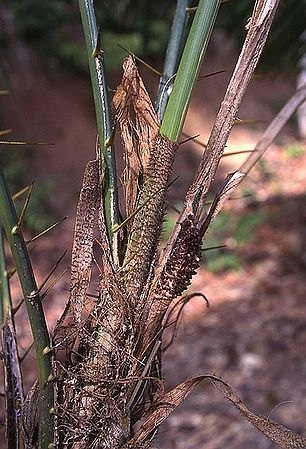Calamus harmandii
| Calamus (KAL-ah-muhs) harmandii (hahr-MAHN-dee) | |||||||
|---|---|---|---|---|---|---|---|
 Laos. Photo by Dr. John Dransfield, Royal Botanic Gardens, Kew/Palmweb. | |||||||
| Scientific Classification | |||||||
| |||||||
| Synonyms | |||||||
|
| |||||||
| Native Continent | |||||||
|
| |||||||
| Morphology | |||||||
| |||||||
| Culture | |||||||
|
| |||||||
| Survivability index | |||||||
|
| |||||||
| Common names | |||||||
|
| |||||||
Contents
Habitat and Distribution
Laos. Indochinese endemic, known only from the type locality. Tropical moist forest, at 150 - 200 m.Description
Calamus harmandii has an erect none climbing stem 0.5-1.1 m tall, 4 cm in diameter with open, not tubular sheaths. With straight spines at the base of the petiole up to 3 cm long. The whole leaf is 1.4-1.7 m long. The leaflets are 40 cm x 1.6 cm with three prominent, bristly veins on the upper surfaces, and the margins are also bristly. Petiole of upper leaves is 35-85 cm long. Inflorescence is errect 1.3-1.4 m long with no flagellum, the branches pressed against the axis. Primary bracts are lacerate, not inflated, and almost unarmed. Male and female flowers are all very crowded, not in neat rows. Dioecious. Fruit as yet unknown.
This species is endemic to one site in south Laos in tropical moist forest at 150-200 m. It has no uses except edible fruit. It is not in cultivation. The species shares similarities to C. acanthophyllus, C. erectus, C. dongnaiensis and especially C. oxycarpus. And also Calamus sp. 'A' Found in neighbouring Vietnam, and has leaflets strongly grouped, up to 24 x 1 cm. Sheath and petiole spines flat, black, in neat rows (like a tiny C. rhabdocladus).
Culture
Cold Hardiness Zone: 10b
Comments and Curiosities
Beccari (1908) placed the locality in Cochinchina but this, and his spelling of it, were in error. The rediscovery of this species was described by Evans (2000). Unconfirmed reports of the species from North Thailand (Evans 2000) are now known to refer to Calamus erectus.
Uses: Fruits edible.
Conservation: The species is currently of conservation concern because it is known from only one site. The locality adjoins a very extensive area of forests at similar altitudes, exploration of which may reveal that it is more abundant. The only threat known at present is forest clearance.
- IMAGE GALLERY
External Links
References
Phonetic spelling of Latin names by edric.
Special thanks to Geoff Stein, (Palmbob) for his hundreds of photos.
Special thanks to Palmweb.org, Dr. John Dransfield, Dr. Bill Baker & team, for their volumes of information and photos.
Glossary of Palm Terms; Based on the glossary in Dransfield, J., N.W. Uhl, C.B. Asmussen-Lange, W.J. Baker, M.M. Harley & C.E. Lewis. 2008. Genera Palmarum - Evolution and Classification of the Palms. Royal Botanic Gardens, Kew. All images copyright of the artists and photographers (see images for credits).
Many Special Thanks to Ed Vaile for his long hours of tireless editing and numerous contributions.





